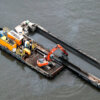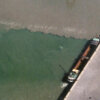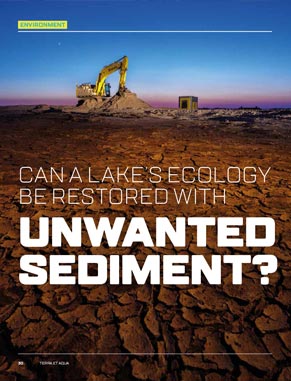“Building with Nature” is a method, in which the starting point is to seek solutions that integrate environment and maritime infrastructure construction.
Eco-dynamic engineering
The Building with Nature approach means evaluating the natural situation as soon as possible when considering the development of maritime infrastructure. The dynamics of the natural system are the starting point. The aim is to pro-actively create an “eco-dynamic” design, integrating nature into the vision of the project from the very beginning. Doing this makes it possible to find solutions that achieve both socio-economic and environmental objectives.
Dredging & nature together
Rather than seeing dredging as separate from nature, or as a threat to natural habitats, Building with Nature provides a way to plan, design and operate infrastructure whilst creating new opportunities for nature and utilising natural forces whenever possible.
Natural elements such as wind, currents, flora and fauna are utilised in designing a hydraulic engineering solution, thus creating additional benefits for nature, recreation and the economy.
Protecting coastal areas
Building with Nature acknowledges that tension often exists between urbanisation and the preservation of natural habitats. This can create difficult choices about how best to go forward, for instance, with coastal zone development.
Coastal areas are attractive for industrial and residential development, yet they also contain valuable natural resources and provide habitats for a variety of marine and wildlife species.
Building with Nature offers a way to alleviate this tension. Through its multi-faceted approach to problems like scarcity of space or accessibility, Building with Nature leads to integrated solutions. These solutions simultaneously improve socio-economic circumstances and preserve and protect environmental assets. The quality of life and the quality of environment are seen as interdependent.
Building with Nature pilot projects
- Sand Engine Sea Defence: Rather than traditional beach nourishment, a concentrated nourishment of 21.5 million m3 of sand was introduced, rising up to 5 metres above mean sea level. The sand is being gradually redistributed by natural processes along the shoreline, beach and dunes. Monitoring shows that this limits the disturbance of local ecosystems and also provides new areas for nature and recreation.
- Hondsbossche and Pettemer Sea Defence: The project involves building a foreshore, a dune and sand nourishment. Monitoring data is being collected to enable evaluation of ‘soft’ solutions for coastal protection.
- “Building with Nature Indonesia” aims to build stable coastlines with reduced risk of erosion and flooding by a unique integration of mangrove restoration, small scale hard-engineering structures and sustainable land use.
Climate change
Climate change, which results in rising sea levels and increased storm-surge frequency and intensity, presents a real threat to coastal and riverine communities. The Building with Nature approach provides an instrument for creating environmentally friendly ways to maintain safety against flooding and reduce or avoid more environmentally harmful interventions.
The Building with Nature process
Building with Nature operates within the triangle “science–technology–society”. These three are in a continual state of interaction:
- Natural sciences are needed to understand how the ecosystem (physical and biological) functions and the social sciences are needed to understand how public decision-making functions and what drives its participants.
- Technology is needed to realise things smoothly, efficiently and effectively.
- Society is the platform for setting standards and for decision-making and is the ultimate stakeholder of all activities.
Early, integrated planning is key in Building with Nature. Lessons learned are collected in the “Building with Nature Design Guideline”.
Other related concepts
Parallel with Building with Nature, the “Working with Nature” concept under the auspices of PIANC, and Engineering with Nature under that of the US Army Corps of Engineers, have been developed.
In 2007-08 EcoShape Institute was formed as a public-private innovation programme with “Building with Nature” at its basis. The initiative is rooted in teamwork and cooperation between the business sector and government authorities.
Subjects
Environment
-
 Building with Nature
Building with Nature
-
 Climate Change
Climate Change
-
 CO2 & Other Emissions / Greenhouse Gases
CO2 & Other Emissions / Greenhouse Gases
-
 Coastal Protection
Coastal Protection
-
 Confined Disposal Facilities
Confined Disposal Facilities
-
 Coral Reefs
Coral Reefs
-
 Deltas
Deltas
-
 Ecosystem Services
Ecosystem Services
-
 Environmental Impact Assessment
Environmental Impact Assessment
-
 Environmental Monitoring
Environmental Monitoring
-
 Environmental Monitoring and Management Plans
Environmental Monitoring and Management Plans
-
 Flood Defence
Flood Defence
-
 Management Practices for the Environment
Management Practices for the Environment
-
 Mangroves
Mangroves
-
 Remediation dredging (Contaminated sediments)
Remediation dredging (Contaminated sediments)
-
 Sustainability
Sustainability
-
 Turbidity
Turbidity
-
 Underwater Sound
Underwater Sound
-
 Wetlands
Wetlands
related
Articles
Deploying private capital to accelerate the green transition

Green solutions in ports, waterways and coastal projects have increasingly become available thanks to many years of research and pioneering efforts in practice. These sustainable and/or nature-based solutions have shown to be good alternatives for classic solutions, but application is far from mainstream yet. One of the major hurdles is the lack of access of private capital to finance these kinds of solutions despite the strong interest of capital markets in green infrastructure opportunities. Identifying the hurdles and paving a way forward to overcome these hurdles could therefore help to increase the uptake of those green solutions.
Climate Risk Overview tool: mapping naturebased flood protection opportunities

The planet is facing enormous challenges caused by human activity, increasing the vulnerability of communities and ecosystems to the forces of nature. This is worsened by the effects of climate change, which is threatening the world’s coastal defences. Van Oord has responded to these challenges by developing the Climate Adaptation Action Plan. The plan is designed to encourage meaningful dialogue between stakeholders in order to provide ready-to-scale marine solutions that help increase the resilience of the communities and ecosystems of coastal areas.
Shaping the engineers of tomorrow

During his distinguished career as professor of Coastal Engineering at Delft University of Technology (TU Delft), Kees d’Angremond served as head of Hydraulic and Offshore Engineering, chair of the department of Hydraulic and Geotechnical Engineering, and dean of the faculty of Civil Engineering from 1989 to 2001. Now professor emeritus, he still works as an advisor and independent consultant. We invited Kees to a conversation with Stefan Aarninkhof, professor of Coastal Engineering and chair of the department of Hydraulic Engineering at TU Delft, to talk about their careers in the dredging industry and the role of academia in the industry today.
The impact and costs of Building with Nature projects

The use of nature and natural processes is an innovative way to increase water safety and create added value through nature development and recreation. This exploratory study provides an initial inventory of the impact and costs of existing Building with Nature projects in the Netherlands. It also includes an analysis of the decision-making process in choosing this type of project and identifies success factors. Building with Nature projects deliver added value but often also involve additional costs compared to traditional reinforcements. These costs give an indication of what we as a society are prepared to pay for the development of nature and recreation as part of hydraulic engineering projects.
The valuation of externalities in maritime infrastructure projects

Climate change and increasing environmental damage are demonstrating the urgency of transformation to a sustainable global economic model. The implementation of the sustainable development concept tends to narrow to integrating environmental, social, and economic concerns in the decision making. In economics, the definition of such concerns is an externality that represents the divergence between social and private costs. This study investigates the available sustainable asset valuation methods that can include the externalities materialised in maritime infrastructure projects and compares them based on economic, social and environmental criteria.
The responsible project: A view on social licence

In today’s world, expectations for sustainable practices are fast becoming the norm. Countries, the public and communities are requesting transparency, the application of higher environmental standards and involvement in decision-making processes when new developments in a marine environment are proposed. Marine infrastructure projects not only require environmental permits and works licences to be in place, they also need a Social Licence to Operate (SLO). This article describes the social licence in this fast-changing context of information and technology, and explores tools that can be used to develop a ‘responsible project’ and provide a successful and sustainable outcome for society and the environment.
Applying the ecosystem services concept in marine projects

A full consideration of ecosystem services (ES) impacts, interactions and improvements can result in more sustainable and adaptive solutions for dredging and marine construction projects. Furthermore, the benefits can be translated in monetary terms, providing returns on investment and highlighting the links between ecology and economy. For some however, the ES concept is too theoretical. This article seeks to show how the ES concept can actively be applied at any point during a project and the benefits of doing so. Its purpose is to provide a framework for integrated and interdisciplinary thinking throughout the different steps of the project cycle.
Creating mangrove habitat for shoreline protection

Over the past decades, there has been a growing interest in exploring innovative ways to minimise the environmental footprint of coastal developments and in nature-based approaches for shoreline protection. At Mubarraz Island near Abu Dhabi (UAE), an international oil company beneficially reused ~12 million m³ of dredged material to protect pipelines, construct a causeway and create mangrove habitat to manage coastal erosion. This ‘Working with Nature’ approach has provided a cost-effective nature-based solution for shoreline protection, with added benefits for biodiversity conservation.
ReefGuard: A Scientific Approach to Active Reef Rehabilitation

ReefGuard, a mobile coral breeding facility provides a highly controlled environment to aid in integrating the breeding and outplanting of corals. This article gives a detailed look into how proven small-scale coral breeding techniques can be scaled-up and applied in practice to promote environmental gain around marine infrastructure projects.
Building with Nature: Sustainable Protection of Mangrove Coasts

Building with Nature is an innovative approach that combines natural processes with innovative engineering methods to realise sustainable projects. Permeable dams are being utilised as part of a Building with Nature solution to help restore the eroding mangrove-mud coast of the Demak district in central Java, Indonesia.
Biogeomorphological Interactions on a Nourished Tidal Flat: Lessons Learnt from Building With Nature
Land in Water, Water in Land: Achieving Integrated Coastal Zone Development by Building with Nature

Although this approach was first applied in the Netherlands, it has gradually been recognised worldwide as a harmonious means of creating land areas for living, working, tourism & recreation, and infrastructure, whilst ensuring the preservation or expansion of valuable environmental resources, nature and landscape. In addition, climate change resulting in sea-level rise, more frequent and intense storm-surges are taken into account, as well as land subsidence and salt water intrusion.
Facts About
Publications
Videos
Presentation: ‘There is ”more” in maritime infrastructure‘ by Marc Huygens (DEME) − Environmental Manager

There are opportunities to develop and implement new solutions for maritime infrastructure challenges. In addition to technical-economical values there is a big commitment to create both environmental and social values. To take the industry to the next level it is necessary to attract students and young professionals to the industry to ensure all externalities are taken into consideration from the onset of a project. The “Social Benefits Wheel” is a tool that can help track the degree to which a project or programme is attaining its social development targets and goals.
Webinars
Webinar: The Multiple Benefits of the Hondsbossche and Pettemer sea dunes, valued by the SAVi methodology

This webinar is especially of interest for policymakers, infrastructure developers, investors and other stakeholders with an interest in green infrastructure. But also for both technical and non-technical professionals in dredging-related industries like consultants and advisors at port and harbour authorities, offshore companies and other organisations that execute dredging projects.























